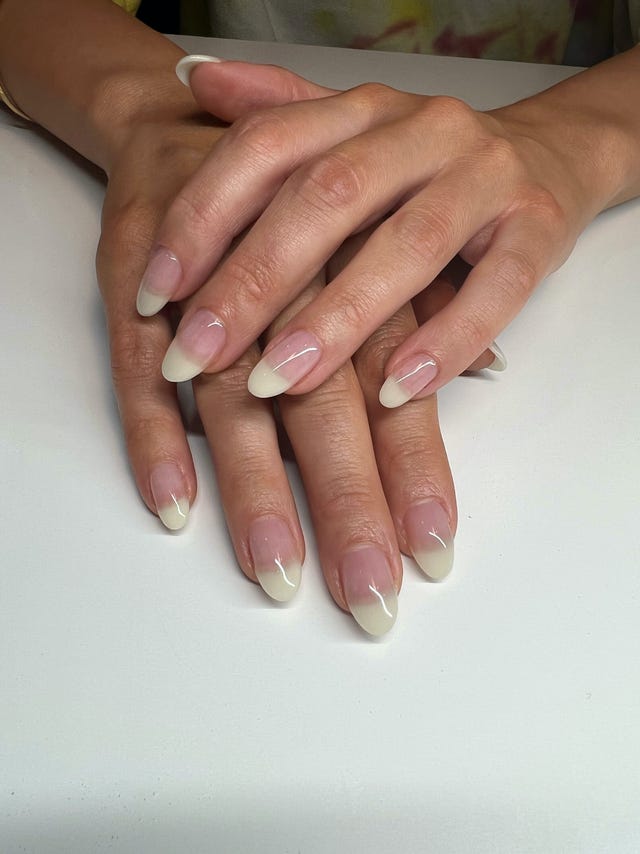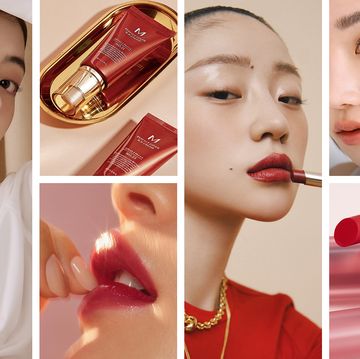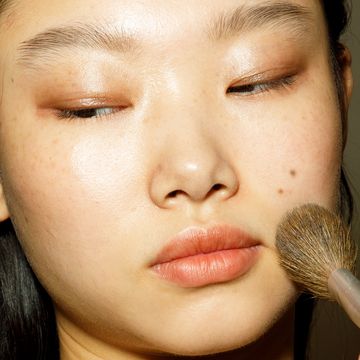My nail journey has been fraught. I have an expansive at-home nail kit, which includes a handy dandy nail drill, UV/LED lamps, and a plethora of nail polishes, but no real patience to do my nails myself. I love the look (and sound) of long nails but can't grow them on my own. On this seemingly neverending journey to photo-perfect nails, I turned to everything from press-ons to acrylics to dip powder. While those are great alternatives to a traditional manicure, I didn't meet my perfect match until I hopped on the gel nail extension bandwagon.
I stopped by Julie Kandalec's Manhattan nail atelier to learn more—and was so excited after that I sent a pic of my gorgeous hand-model-worthy mani to one of my best friends. She assumed the hand pic was me announcing I was engaged. Nope, just excited about my manicure. If you, too, would like to experience the same excitement I felt after a fresh gel extension set, read on for everything you need to know before you book your next session.
What are gel extensions?
Gel extensions give you the look of long, acrylic nails (the material is similar to that used in extensions) but are much lighter and have less risk of damaging the nail when it comes to removal. Gel nail extensions are made of "a molecule called an oligomer that usually comes in a pot and is the consistency of honey," says celebrity nail artist Julie Kandalec. "Gel extensions are created when the hard or semi-hard gel is sculpted, cured, and then shaped to add length and strength to the nail."
Gel nails are a healthier alternative to acrylic nails, adds freelance nail artist Trenna Seney. And while you might be tempted to channel your inner nail artist, Seney recommends resisting the urge to do gel extensions. Instead, please seek a professional like herself, Kandalec, or Eunice Park, research and development manager at Aprés Nail.
What's the difference between gel extensions and acrylics?
What separates gel and acrylic nails is the nail's material. “Acrylic extensions require two components: monomer and polymer, to create extensions. Monomer often has a very strong odor that can be off-putting for some clients. But acrylic does offer very durable nails and can be built out to a long length. Gel has no odor and requires curing under an LED or UV light,” Park explains.
Are there different kinds of gel extensions?
There are two basic types: hard gel and soft gel. In short, hard gels are non-porous, making them acetone-resistant. “These enhancements are powerful and can be worn long and filed into different shapes like coffin, stiletto, and ballerina,” Kandalec says. Soft gels (like classic gel polish) are porous. That’s why they can be soaked off with acetone—but cannot be made into extensions. A semi-hard gel is a hard enough hybrid to be made into extensions but can also be soaked off (it just takes longer).
But if you've scrolled on Instagram or TikTok long enough, you might've come across a company named Apres Gel-X. “Aprés created Gel-X®, the world's first full-coverage soft gel extension system, to cut down the time of traditional gel extensions without sacrificing shape or durability,” Park explains. Instead of using a nail form papers or free-handing the gel extensions, Apres' gel-x tips “come fully formed with the desired shape and length.” Some of the extension styles include natural coffin medium or a sculpted almond long. “Each tip box comes with 14 sizes, including half sizes so it's even easier to size each nail for the most perfect fitting tip. For pros, Gel-X allows them to provide faster, more consistent service that saves them more time for the fun parts of service like nail art. Gel-X is made of soft gel, it can be easily soaked off with acetone,” she adds.
What are the benefits of gel extensions?
“Gel-X is a great product for protecting weak or brittle nails. Gel-X can also be a great interim product to use while the wearer is growing out their own nails,” Park adds. Apres Gel-X recently launched a line of extra short nails for those who prefer a more natural style.
What are the cons?
If you prefer long extensions, Park advises getting something more durable than soft gel as “some of the cons of traditional soft gel extensions is that they can be too soft for long extensions. Soft builder gels typically can only create tiny extensions. Also, hard gel can't be soaked off, it must be filed off,” she explains. Since hard gel has to be filed off, you run the risk of overfilling the natural nail, which can weaken and damage your nails.
How long do gel nail extensions last?
“Most clients that wear gel extensions go two to four weeks between appointments,” says Kandalec, who uses the CND Plexigel on her clients. “They come in for a 'fill' to rebalance the nail. This is important because it re-positions where the strongest part of the nail is to prevent damage from the tip being too heavy.”
How much do gel extensions typically cost?
The cost of gel extensions varies from city to city. At New York's popular nail salon Vanity Projects, Apres Gel-X sets can start as low as $150.
How are gel extensions applied?
- Step 1: Prep the nails. The nail tech will file the client’s nails, push cuticles back, trim dead cuticles, and buff nails. The nails must be clean (and dry) before application.
- Step 2: After the tech applies a bonder for longevity, they will place a tip or paper form to get the shape and length, and then build up the gel atop that to create the desired length and shape.
- Step 3: The nail is cured between each layer of gel.
- Step 4: Once the set is completely built, it's filed further to the perfect shape.
- Step 5: The gel extensions can either be left as is or painted.
- Step 6: Finish with a top coat for an ultra-glossy shine that lasts weeks.
What's the aftercare like for gel extensions?
It's important to let your natural nails get some oxygen between extension sets. Both agree that cuticle hydration, in the form of great oil, is key.
How do you remove gel extensions?
If you have hard or semi-hard gel extensions on, a professional needs to remove your set. “First, the enhancement is gently filed down to about 10-15% of its thickness, avoiding filing the natural nail,” Kandalec says. “The rest is soaked off by saturating a small piece of cotton in pure acetone and wrapped in foil. After about 15-20 minutes, the remainder will flake away, leaving behind a healthy nail.”
Meet the experts
Julie Kandalec is an NYC-based celebrity manicurist and founder of Julie K Nail Artelier
Trenna Seney is a Harlem-based celebrity nail artist
Eunice Park is the research and development manager at Aprés Nail
Why trust ELLE Beauty?
Margaux Anbouba is ELLE's Beauty Editor. She has interviewed countless makeup artists and is always testing out new makeup and skincare products.
Nerisha Penrose is the Beauty Commerce Editor at ELLE.com. Since joining ELLE.com in 2017, she has interviewed countless skincare professionals and personally tested the latest and greatest products across makeup, skincare, and hair care.















